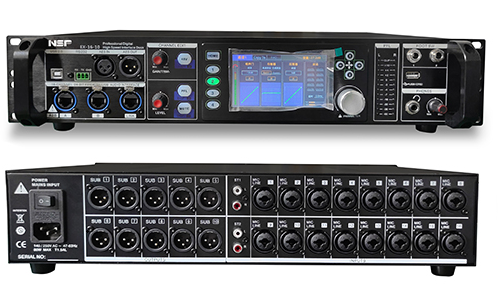Advantages and Disadvantages of Rackmount Digital Mixers
Rackmount digital mixers have revolutionized audio production, offering powerful tools in a compact form factor. These mixers are popular among professionals in live sound, studios, and installations due to their space-saving design and advanced features. Whether you are a seasoned audio engineer or exploring options for your setup, understanding the advantages and disadvantages of rackmount digital mixers is essential. This guide will provide a detailed overview, helping you determine if they are the right choice for your needs.

What Are Rackmount Digital Mixers?
Overview of Rackmount Digital Mixers
Rackmount digital mixers are audio mixing devices designed to fit into standard equipment racks. They combine the flexibility of digital audio processing with a compact, rack-mounted form factor. Unlike traditional mixing consoles, these mixers often rely on remote control via tablets, laptops, or dedicated hardware, making them ideal for situations where space is limited.
How Rackmount Digital Mixers Work
At their core, rackmount digital mixers handle multiple audio input channels, processing them digitally to deliver outputs tailored to the user’s requirements. They come equipped with features like equalization (EQ), dynamics processing, and effects, controlled through software interfaces.
Advantages of Rackmount Digital Mixers
Space Efficiency
One of the biggest advantages of rackmount digital mixers is their compact size. Traditional mixing consoles can take up significant space, especially in mobile setups or venues with limited room. A rackmount unit neatly fits into a standard equipment rack, leaving more space for other gear.
Remote Control and Flexibility
Rackmount digital mixers are typically controlled via remote devices, such as tablets or laptops. This offers incredible flexibility, allowing sound engineers to mix audio from any location within the venue. This feature is particularly useful for live sound applications, where adjusting settings in real-time is crucial.
Advanced Features
Most rackmount digital mixers come packed with advanced audio processing tools, including:
- High-resolution equalizers
- Built-in compressors and limiters
- Multi-effects processors
- Automated mixing capabilities
These features make them suitable for both live and studio applications.
Cost-Effective Solution
Compared to traditional large-format mixing consoles, rackmount digital mixers are often more affordable while offering comparable functionality. This makes them a great option for small venues, churches, and mobile sound setups.
Durability and Portability
Designed for rack-mounted setups, these mixers are robust and can withstand the rigors of touring or frequent relocation. Their compact design also makes them easier to transport than full-sized mixing consoles.
Disadvantages of Rackmount Digital Mixers
Steeper Learning Curve
For users accustomed to traditional consoles, transitioning to a rackmount digital mixer can be challenging. The lack of physical faders and controls means operators must become comfortable with touchscreen or software-based interfaces.
Dependence on External Devices
Rackmount digital mixers rely on external devices for control, such as tablets or laptops. If the control device fails or experiences connectivity issues, accessing the mixer’s functions can be problematic.
Limited Physical Controls
Unlike traditional mixing consoles, rackmount digital mixers lack physical knobs and faders. While this design saves space, some users find it less intuitive or slower to operate, especially during live performances where quick adjustments are needed.
Connectivity Challenges
Although rackmount mixers are designed to integrate with digital systems, they may require additional networking or hardware setups to function seamlessly. This can increase complexity for users unfamiliar with networked audio systems.
Dependence on Power and Network Stability
As digital devices, rackmount mixers depend on reliable power and network connections. Power outages or network disruptions can lead to significant challenges, particularly in live environments.
Applications of Rackmount Digital Mixers
Live Sound
Rackmount digital mixers are commonly used in live sound setups for concerts, theaters, and corporate events. Their compact design and remote control capabilities make them ideal for tight spaces and dynamic environments.
Studio Recording
In recording studios, rackmount digital mixers serve as central hubs for managing multiple audio sources. Their advanced processing tools and compatibility with digital audio workstations (DAWs) enhance productivity and sound quality.
Installations
Venues like churches, schools, and conference halls benefit from the scalability and space-saving design of rackmount digital mixers. These mixers can be integrated into permanent setups, providing reliable audio management.
Features to Look for in Rackmount Digital Mixers
Channel Capacity
Ensure the mixer supports the number of input and output channels required for your application.
Audio Processing Capabilities
Look for mixers with built-in EQs, compressors, and effects processors to minimize the need for external gear.
Remote Control Options
Choose a mixer compatible with your preferred control devices, such as iPads, Android tablets, or PCs.
Build Quality
Select a model built with durable materials to withstand frequent use, especially if you plan to transport it regularly.
Compatibility with Existing Equipment
Make sure the mixer integrates seamlessly with your current audio setup, including microphones, speakers, and other devices.
Popular Rackmount Digital Mixer Models
Several brands are known for their high-quality rackmount digital mixers:
- Behringer X32 Rack: Offers extensive features at an affordable price, making it a favorite among budget-conscious users.
- Allen & Heath SQ Series: Known for its high-quality sound and advanced processing capabilities.
- Yamaha TF Rack: Combines user-friendly controls with robust audio processing tools, ideal for live and studio use.
Rackmount digital mixers have become an essential tool in modern audio production, offering a compact, feature-rich alternative to traditional mixing consoles. Their advantages, including space efficiency, remote control capabilities, and advanced audio processing, make them ideal for a wide range of applications. However, potential drawbacks, such as reliance on external devices and a steeper learning curve, should be carefully considered before investing in one.
Whether you’re setting up a live sound system, upgrading your studio, or planning a permanent installation, rackmount digital mixers provide a versatile and cost-effective solution. By understanding their advantages and disadvantages, you can make an informed decision and unlock their full potential in your audio projects.